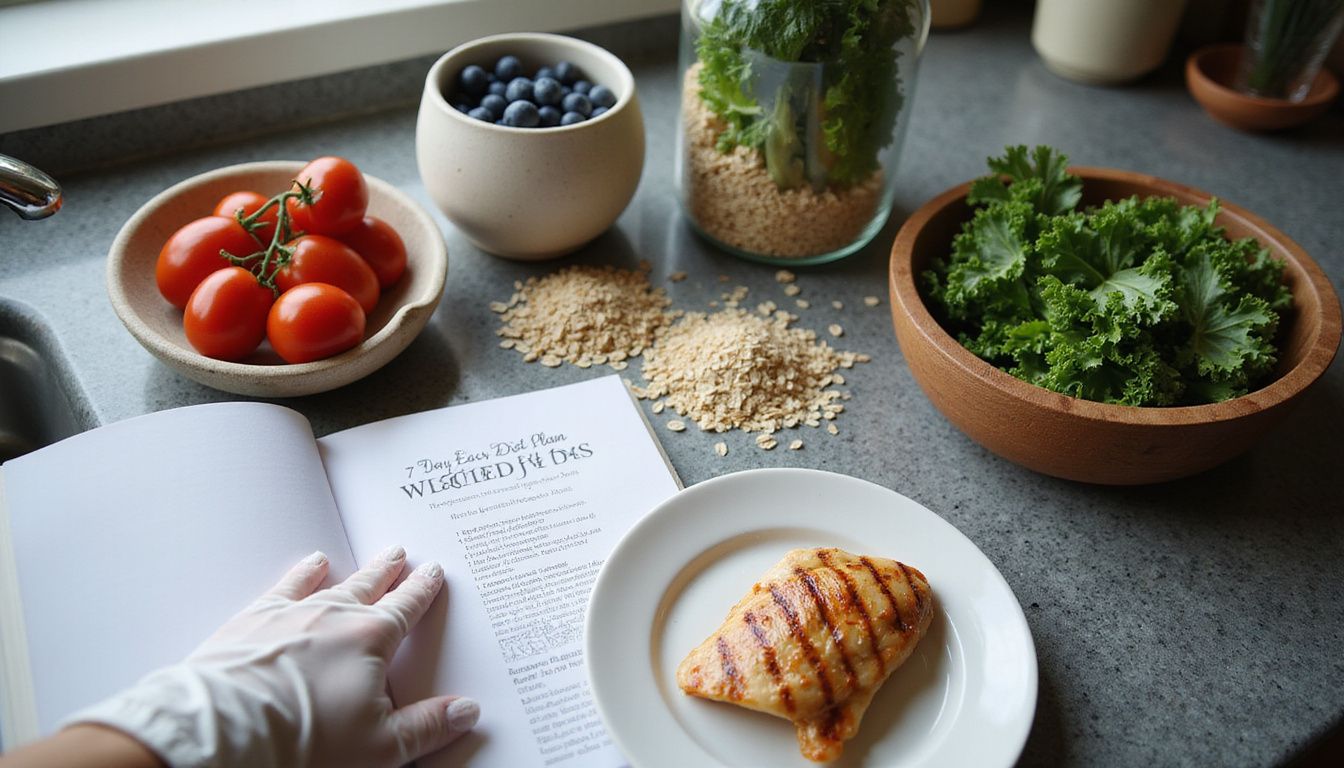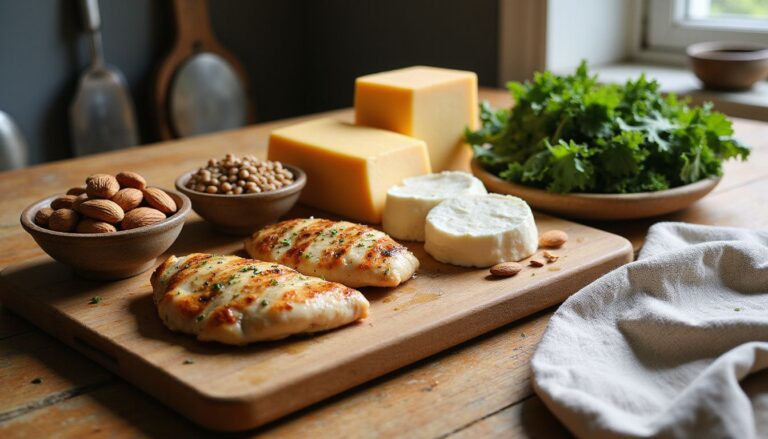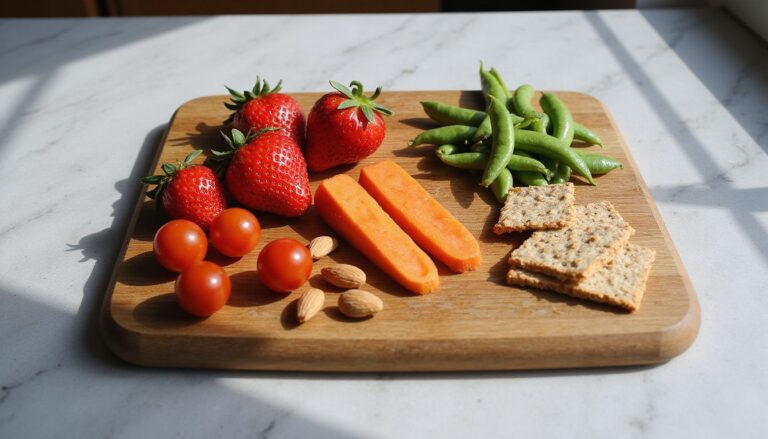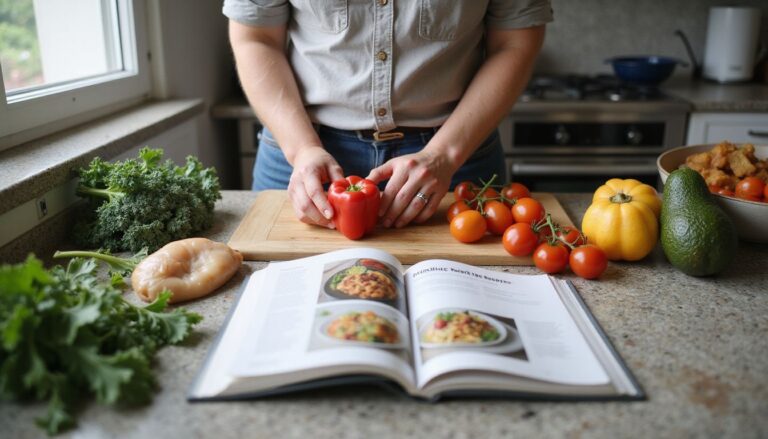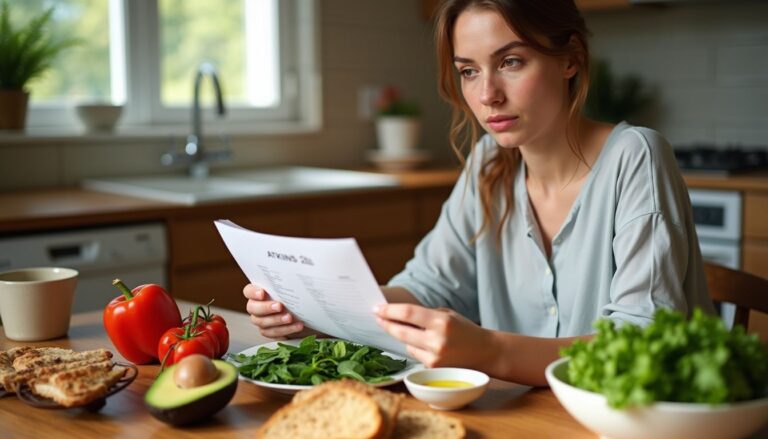7-Day Easy Diet Plan For Weight Loss: Your Ultimate Meal Guide
Our Nutrition Assistant AI Suite will transform your body. You will lose fat, get toned, and build muscle. Gain confidence and optimal health.
Losing weight gets easier with a clear plan. A simple diet plan for weight loss helps you choose smart meals, control calories, and stay consistent. This guide gives you a practical 7-day meal plan, plus tips to make healthy eating part of your daily routine.
You will see balanced meals, easy prep ideas, and quick swaps you can use right away. The goal is progress, not perfection. Start with small changes, track what works, and build from there.
Key Takeaways
- Creating a calorie deficit, using more energy than you eat, is key for weight loss. Many adults do well at about 1,200 calories per day, but needs vary by size, activity, and health conditions (Mayo Clinic Diet).
- Balanced plates include whole grains, lean protein like fish or chicken, vegetables, fruit, and healthy fats. This mix supports fullness and steady energy.
- Weekly meal prep, such as cooking grains and proteins in bulk, helps with portions and prevents overeating during your 7-day plan.
- Safe weight loss often averages 1 to 2 pounds per week after an early drop, similar to the Mayo Clinic Diet’s first phase.
- Hydration, fewer processed foods, less added sugar, and regular physical activity support long-term weight management.
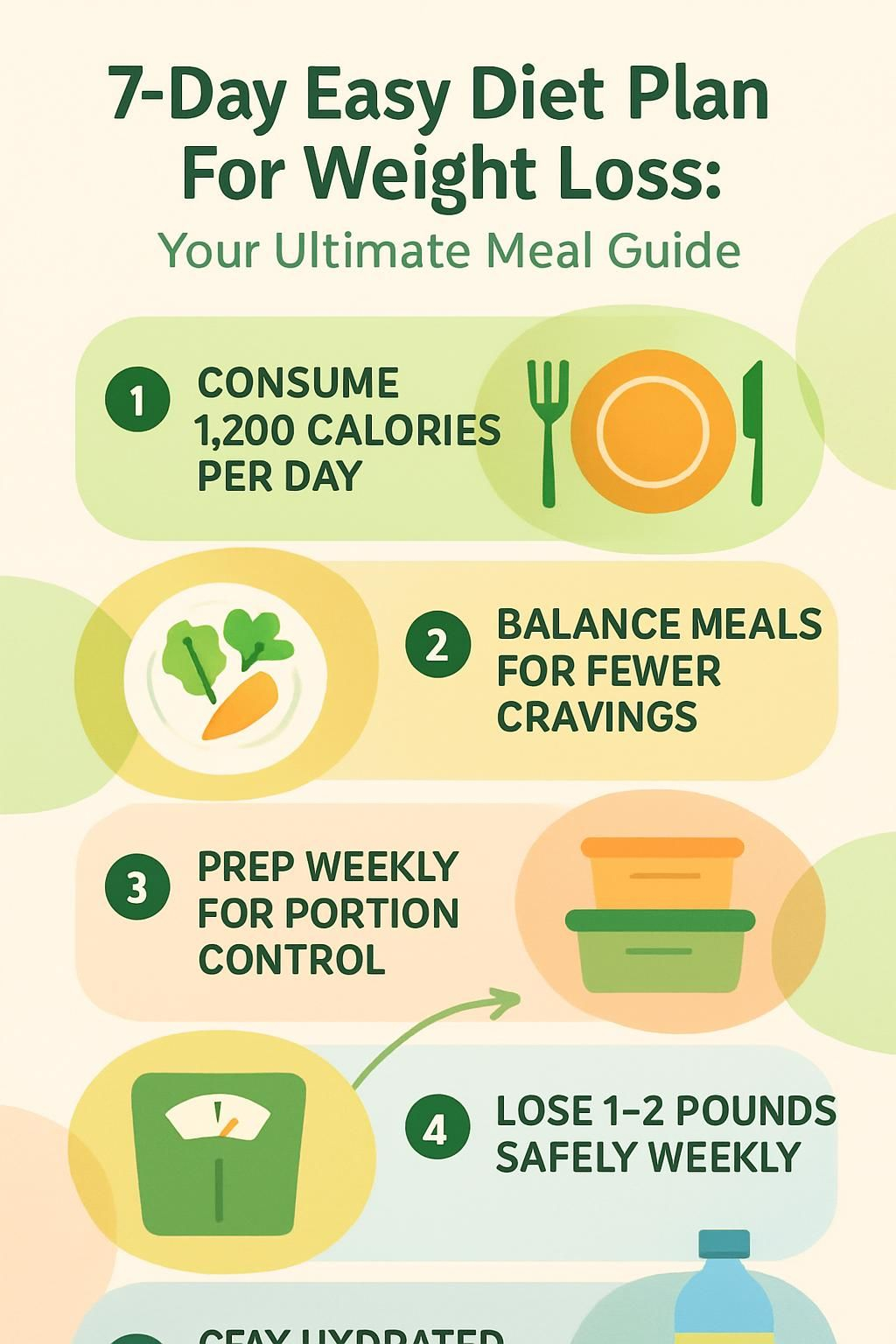
Key Principles of a 7-Day Diet Plan
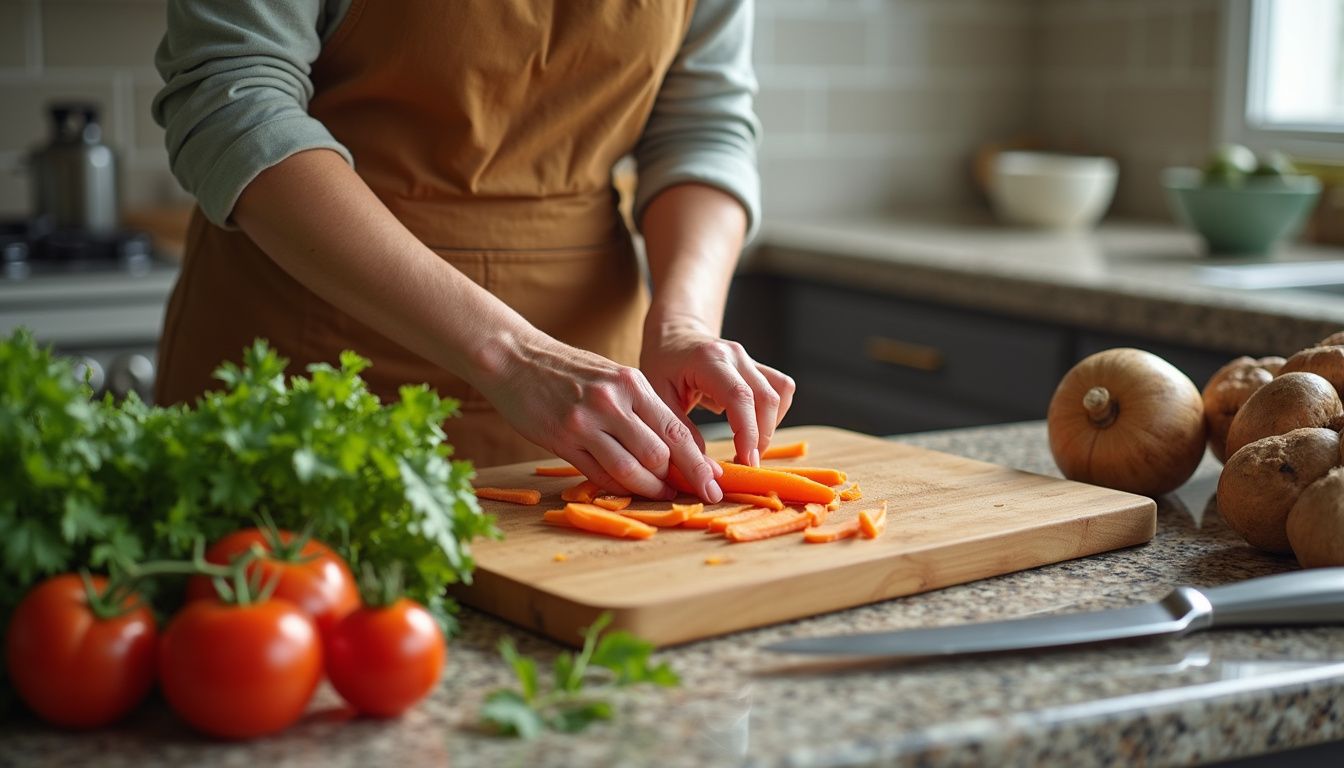
A structured diet meal plan guides your choices and keeps total calories in range. Balanced nutrition builds habits you can keep, which supports steady, healthy weight loss.
Why is calorie management important for weight loss?
Calorie management matters because weight loss occurs when you burn more energy than you eat. This is called a calorie deficit. Many adults maintain weight at 1,500 to 2,000 calories per day. A meal plan around 1,200 calories can help your body use stored fat for fuel.
The Mayo Clinic Diet highlights portions and nutrient-rich foods like vegetables, fruits, and whole grains. These foods are lower in calories but high in vitamins and fiber. Tracking intake with a journal or app can reduce mindless snacking and help you spot habits that need a tweak.
Some people need more than 1,200 calories, especially if very active or managing conditions like diabetes. Speak with a healthcare professional before starting a restrictive plan.
“For healthy weight-loss success, focus on what goes into each meal as well as how much—portion size matters just as much as ingredient quality.”
How does balanced nutrition support weight loss?
Balanced nutrition covers all the food groups, so your body gets what it needs while you reduce calories. Pair vegetables and fruit with whole grains, beans, lean proteins, and healthy fats like olive oil or nuts. This combination supports fullness, steady blood sugar, and fewer cravings.
Fiber from oats, brown rice, quinoa, beans, broccoli, and berries slows digestion and helps you stay satisfied. Choosing nutrient-dense foods over ultra-processed options can also lower long-term risks for heart disease and type 2 diabetes. Many people notice better energy and focus when they shift calories toward whole foods.
How to Get Ready for Your 7-Day Diet Plan
A short planning session sets you up for success. Prep your kitchen, set targets, and map simple meals so the healthy choice becomes the easy choice.
How can I set realistic weight loss goals?
Build goals around science and your health needs. The Mayo Clinic Diet outlines an early two-week phase with a 6 to 10 pound drop for some people, then a pace of 1 to 2 pounds per week. This range is achievable and easier to maintain.
Check in with a clinician if you have high blood pressure, diabetes, or other conditions. I once chased fast results and burned out. Aiming for one pound per week felt doable and kept me engaged.
Track progress weekly, not daily. Focus on habits you can keep, like planned snacks, water before meals, and regular movement.
What essentials should I stock up on?
A thoughtful grocery list keeps your 7-day meal guide simple and affordable.
- Whole grains: brown rice, oats, quinoa, whole grain bread.
- Beans and lentils: canned black beans, chickpeas, and lentils for budget-friendly protein.
- Lean proteins: eggs, chicken breast, turkey, and tofu.
- Produce: spinach, apples, bananas, berries, carrots, sweet potatoes, and frozen options.
- Dairy or alternatives: nonfat yogurt, Greek yogurt, cottage cheese, or fortified soy yogurt.
- Healthy fats: almonds, walnuts, natural peanut butter, seeds, olives, and olive oil.
- Tools: meal prep containers and a kitchen scale for portion control.
- Flavor boosters: cinnamon, vinegar, mustard, salsa, cumin, garlic, and herbs.
- Buy some staples in bulk to save money and reduce extra trips.
Keeping these on hand helped me avoid late-night takeout and stick to my weight loss meal plan.
What are effective meal preparation tips?
Set aside a single prep block to reduce stress all week. A little work now saves time every day.
- Map your 7-day menu and write a clean grocery list. Planned meals reduce impulse buys.
- Cook grains like quinoa or brown rice in bulk. Store in airtight containers for fast sides.
- Batch-cook proteins such as chicken, hard-boiled eggs, or tofu for salads, wraps, and bowls.
- Wash and chop vegetables, then store them in clear containers for quick access.
- Use leftovers smartly. Turn roasted veggies into a lunch wrap or blend Greek yogurt into a sauce.
- Pre-portion snacks like nuts or frozen berries to manage calories between meals.
- Pick recipes with overlapping ingredients, such as hummus for snacks and sandwiches.
- Keep prepared items visible in the fridge so healthy choices come first.
- Cook at home as much as possible to control added sugar, salt, and oils.
- Adjust portion sizes to match your calorie needs and activity level.
These strategies support plant-forward eating, reduce food waste, and keep your plan realistic.
7-Day Easy Diet Plan for Weight Loss
This 7-day plan focuses on whole foods, simple prep, and steady energy. Use it as a template and swap items to fit your taste, budget, and any dietary needs.
Day 1:
Start the week with nutrient-dense meals that are easy to assemble and kind to your budget.
- Breakfast option 1: bran flakes with sliced banana for fiber and potassium.
- Breakfast option 2: oatmeal with banana and cinnamon plus a hard-boiled egg.
- Lunch option 1: turkey pita with roasted pepper and mustard on whole wheat.
- Lunch option 2: turkey sandwich with carrot sticks for crunch and antioxidants.
- Lunch option 3: Veggie Niçoise pita with hummus, red peppers, chickpeas, and olives, about 290 calories.
- Dinner option 1: 4 oz Zesty Lemon-Herb flounder, under 200 calories.
- Side ideas: couscous and steamed broccoli for fiber and quick cooking.
- Dinner option 2: grilled chicken with steamed broccoli and brown rice.
- Dessert: one single-serve ice cream to prevent feeling deprived.
- Hydration: water or herbal tea to support digestion and appetite control.
What should I eat for breakfast on Day 1?
Pour 3/4 cup bran flakes into a bowl. Top with a sliced banana and add 1 cup of fat-free milk for protein and calcium. For a budget swap, cook a half cup of oats with banana and cinnamon.
Both choices offer fiber from whole grains and fruit. They support steady energy until lunch and fit typical calorie goals.
What is a healthy lunch option for Day 1?
Fill a mini whole wheat pita with 3 ounces of turkey, half a roasted pepper, 1 teaspoon mayo, mustard, and lettuce. Add a stick of part-skim mozzarella and two kiwis for a balanced plate.
Prefer vegetarian? Make veggie Niçoise pitas with hummus, red peppers, chickpeas, and olives. On busy days, a simple turkey sandwich with carrot sticks works well and travels easily.
What dinner works best for Day 1?
Grill 4 oz flounder or chicken for lean protein. Add 1 cup cooked couscous and 1 cup steamed broccoli for fiber and whole grains. Include a single-serve ice cream if you want something sweet.
Grilling and steaming keep extra fat low. Ending with a small dessert can reduce late-night snacking. Sip water or herbal tea to round out the meal.
Day 2:
Day 2 keeps the focus on whole foods, lean proteins, and hydration to support weight loss.
- Breakfast: smoothie with frozen berries, half banana, Greek yogurt, and almond milk.
- Snack 1: a small apple for natural sweetness and fiber.
- Lunch: vegetable lentil soup with a slice of whole grain bread.
- Alternate lunch: mushroom-quinoa burger without heavy toppings.
- Snack 2: a cup of grapes for hydration and quick energy.
- Dinner: barbecue cutlets made from lean beef or chicken, about 265 calories per serving, with citrus slaw or sautéed spinach and a baked potato.
- Drinks: water or unsweetened tea. Skip sugary beverages.
- Limit highly processed foods, extra salt, and added sugar.
- Add simple movement, such as a 30-minute walk, to aid digestion.
- Use mustard instead of creamy sauces to save calories.
What should I eat for breakfast on Day 2?
Blend 1 cup frozen berries, half a banana, and 8 ounces low or fat-free milk for a quick smoothie. For more protein, add 1 to 2 hard-boiled eggs. Keep breakfast under 300 calories to support your plan.
On a tight budget, top Greek yogurt with mixed berries. This combo kept me full through morning workouts and prevented early cravings.
What is a healthy lunch option for Day 2?
Have a veggie burger on whole grain toast or an English muffin. Pair with one cup of vegetable soup for fiber and hydration. Whole grains give steady energy while plant protein supports fullness.
Another option is lentil soup with whole grain bread. Include a cup of grapes as your fruit. These choices support weight loss with high nutrients and modest calories.
What dinner works best for Day 2?
Choose barbecue cutlets with citrus slaw or sautéed spinach in olive oil and garlic. Add tomato slices and half a baked potato. You can also stir-fry tofu with mixed vegetables and serve it with quinoa for a plant-based twist.
Olive oil adds healthy fats that boost flavor and satiety. Keep portions moderate to stay within your daily target.
Day 3:
Today’s meals blend comfort and nutrition with easy prep steps you can repeat.
- Breakfast: oatmeal with chopped apple and a small drizzle of honey.
- Lunch: chicken salad with grapes and 1/4 cup almonds over spinach.
- Dinner: steamed shrimp with a baked potato for protein and fiber.
- Budget swaps: spinach-banana smoothie, tuna salad on lettuce, and baked salmon with sweet potatoes and green beans.
- Snack: 1/4 cup almonds to tame hunger with healthy fats.
- Dessert: 1 ounce of chocolate or a 100 to 150 calorie ice cream bar.
- Cooking methods: try roasting or sautéing instead of frying.
- Hydration: drink 6 to 8 glasses of water, avoiding sugary drinks.
- Focus on whole foods and skip ultra-processed snacks.
- Stay active with a brisk walk or light cycling.
- Plan ahead to save time on busy weekdays.
What should I eat for breakfast on Day 3?
Cook 1/2 cup quick oats in low-fat milk or unsweetened soy milk. Top with half an apple, one teaspoon honey, and cinnamon. This blend gives fiber and steady energy.
Short on time? Blend spinach, banana, and almond milk. Both breakfasts support even blood sugar and keep you full.
What is a healthy lunch option for Day 3?
Make chicken salad with 4 ounces shredded chicken, 1/4 cup sliced red grapes, 1 tablespoon slivered almonds, 1/4 cup chopped celery, and 1 tablespoon each mayo and Greek yogurt. Serve on lettuce with a slice of multigrain toast.
For a lower-cost option, try tuna salad on lettuce with tomato and cucumber. I bring nutty salads like this to work because they fill me up without a mid-afternoon crash.
What dinner works best for Day 3?
Steam 4 oz shrimp. Bake a potato and top with 3 tablespoons salsa and 1 tablespoon unsweetened Greek yogurt. Steam 3 cups spinach for antioxidants and micronutrients. Choose one dessert, either 1 ounce chocolate or a 100 to 150 calorie ice cream bar.
This meal hits protein, fiber, and vegetables while staying within calorie goals. On busy nights, switch to baked salmon, sweet potatoes, and green beans.
Day 4:
Fresh flavors and lean protein anchor Day 4, with simple swaps if you need to budget.
- Breakfast: Greek yogurt topped with a handful of berries; scrambled eggs with spinach as an add-on if desired.
- Lunch: tomato soup and a roast beef pita, plus 2 cups raw veggies and 1/4 cup hummus.
- Dinner: poached salmon with a quick slaw, and a side of brown rice or quinoa.
- Budget swaps: eggs with spinach for breakfast, chickpea salad for lunch, and turkey meatballs with whole wheat spaghetti in marinara for dinner.
- Snack: carrot sticks with 2 tablespoons hummus.
- Plan recipes that reuse ingredients to save time and money.
- Prioritize whole foods and lean proteins to support weight loss.
What should I eat for breakfast on Day 4?
A balanced breakfast keeps you focused. Have 1 cup plain or low-sugar Greek yogurt topped with 1 cup berries. You can scramble two eggs with spinach for extra protein. Research suggests higher protein in the morning can curb hunger later in the day (American Journal of Clinical Nutrition, 2015).
What is a healthy lunch option for Day 4?
Pair 1 cup tomato soup with a mini whole-wheat pita stuffed with 3 ounces roast beef, 1 teaspoon horseradish, mustard, lettuce, and tomato. Add 2 cups raw veggies and 1/4 cup hummus for fiber and healthy fats.
If you need to cut costs, make a chickpea salad with mixed greens and a light vinaigrette. These lunches pack well for school or work and kept me full until dinner.
What dinner works best for Day 4?
Poach 4 oz salmon. Make a slaw with 1 1/4 cups coleslaw mix, 2 sliced scallions, 1 tablespoon rice vinegar, and 1.5 teaspoons olive oil. Add 1 cup cooked quinoa or brown rice for staying power.
Meals higher in fiber and lean protein help manage hunger and energy through the evening (Harvard T.H. Chan School of Public Health, Nutrition Source).
Day 5:
Day 5 features fast meals with familiar ingredients that fit a busy schedule.
- Breakfast: Cheerios with berries and sliced almonds for fiber and healthy fats.
- Budget breakfast: whole grain toast with peanut butter and banana.
- Lunch: mushroom quesadillas with a side of fresh vegetables.
- Alternate lunch: quinoa bowl with black beans, corn, and tomatoes.
- Snack: one small orange for vitamin C and a sweet bite.
- Dinner: balsamic-glazed pork tenderloin with roasted butternut squash, about 370 calories per serving.
- Keep prep time under 30 minutes and include a protein source at each meal.
- A small serving of nuts in the afternoon can blunt cravings and support energy.
What should I eat for breakfast on Day 5?
Serve 1 cup Cheerios with 1/2 cup berries and 1 tablespoon slivered almonds. Add 6 ounces plain Greek yogurt on the side for extra protein. For a cheaper option, toast one slice whole grain bread, spread peanut butter, and top with banana slices.
Both breakfasts are filling and support steady energy into the afternoon.
What is a healthy lunch option for Day 5?
Sauté sliced mushrooms and tuck them into a whole wheat tortilla with shredded low-fat cheese. Grill until crisp. Add cucumber spears for a hydrating crunch.
Round out lunch with 1/2 cup 2 percent cottage cheese or Greek yogurt and two clementines. You get protein, produce, and fiber without stretching your budget.
What dinner works best for Day 5?
Make balsamic-glazed pork tenderloin with honey and thyme for flavor without excess fat. Roast butternut squash on the side for complex carbs and fiber. Many ingredients overlap with earlier meals, which saves money and time.
This lean protein dinner fits a 1,200-calorie day and supports muscle health.
Day 6:
Day 6 keeps variety high while relying on repeat staples to simplify shopping and prep.
- Breakfast: a 100 percent whole-grain frozen waffle with nut butter and banana.
- Add an 8-ounce glass of fat-free milk for protein and calcium.
- Lunch: tuna salad made with low-fat mayo and nonfat yogurt, about 135 calories per serving.
- Sides: ten baby carrots and 2/3 cup plain Greek yogurt.
- Snack: a small pear for fiber and sweetness.
- Dinner: spicy sausage jambalaya with three cups sautéed spinach in olive oil and garlic.
- Repeat ingredients from earlier days to keep costs low.
- Balance protein, fiber, and healthy fats to support energy and appetite control.
This mix is practical for busy weeks and helps you stay consistent.
What should I eat for breakfast on Day 6?
Toast a whole-grain waffle and spread two tablespoons nut butter. Top with one small banana, plus cinnamon or nutmeg for flavor. Pour an eight-ounce glass of fat-free milk to complete the meal.
This fast breakfast delivers carbs, protein, and healthy fats that keep you full.
What is a healthy lunch option for Day 6?
Make tuna salad with low-fat mayo and nonfat yogurt. Pair it with 10 baby carrots, 2/3 cup plain Greek yogurt, and a small pear. The protein and fiber help steady your appetite until dinner.
What dinner works best for Day 6?
Cook spicy sausage jambalaya for bold flavor and satisfying protein. Serve with 3 cups spinach sautéed with garlic in 1 tablespoon olive oil. Add a slice of toast or a small orange if you need more carbohydrates.
Using familiar ingredients across the week keeps this plan budget-friendly and easy to follow.
Day 7:
Finish strong with plant-forward meals and simple proteins that come together quickly.
- Breakfast: half a toasted English muffin with reduced-fat cheese, tomato, spinach, and a poached egg. Add grapefruit.
- Lunch: black bean salad with orange segments, chopped veggies, vinegar, salad greens, one stone ground corn tortilla, and a piece of fruit.
- Dinner ideas: focus on beans, roasted vegetables, and whole grains.
- Drink at least eight glasses of water to support appetite and energy.
- Use smaller plates and bowls to guide portions.
- Smart snacks: fruit, a handful of nuts, or sliced vegetables.
- Lean on low-cost staples such as beans and whole grain toast to stretch your budget.
- Avoid ultra-processed foods and sugary drinks to finish the week on track.
What should I eat for breakfast on Day 7?
Top half an English muffin with 1 ounce reduced-fat cheese, sliced tomato, and 1 cup spinach. Add one poached egg. Serve with one grapefruit for vitamin C and fiber.
This balanced breakfast delivers about 300 to 350 calories and supports morning focus.
What is a healthy lunch option for Day 7?
Combine 1/2 cup canned black beans with 1/2 cup chopped orange, peppers, onions, and scallions. Toss with 1 teaspoon vinegar and serve over salad greens. Add one stone ground corn tortilla and a piece of fruit.
This meal offers plant protein and antioxidants, which help you feel full and support health goals (Harvard T.H. Chan School of Public Health, 2023; CDC, 2022). It takes less than ten minutes to prepare and keeps you satisfied through the afternoon.
What dinner works best for Day 7?
Prepare grilled chicken breast with roasted broccoli and brown rice. Broccoli brings fiber, and brown rice offers complex carbohydrates. Top with a small handful of chopped nuts for healthy fats and crunch. Enjoy orange slices for dessert.
Fill half your plate with vegetables, one quarter with lean protein, and one quarter with whole grains. This simple visual helps with portion control.
How Can I Stay on Track During the 7-Day Diet?
Consistency beats intensity. Use simple daily habits that nudge you toward your goals.
How much water should I drink each day?
Drinking enough water can support metabolism and reduce false hunger. Aim for pale yellow urine as a simple sign of good hydration. Replacing sugary drinks with water cuts excess calories and may improve energy.
Keep a reusable bottle nearby. I noticed fewer afternoon cravings once I started sipping water between meals.
How do I manage portion sizes effectively?
Portion control keeps your calories in line. A helpful guide is to fill half your plate with vegetables, one quarter with lean protein, and one quarter with whole grains. If hunger lingers, add more vegetables or include a piece of fruit.
Use measuring cups or a food scale to learn true serving sizes. If your needs differ from a 1,200 calorie day, adjust portions. A registered dietitian can tailor portions to your goals and health status.
What light exercises complement this diet plan?
Light daily movement supports weight management and mood. The Mayo Clinic suggests at least 30 minutes of activity most days.
- Walk briskly for 30 minutes.
- Do bodyweight squats and wall push-ups.
- Stretch or practice gentle yoga for 10 minutes.
- Bike outdoors or on a stationary bike for 20 to 30 minutes.
- Climb stairs for short bursts.
- Stand and move during phone calls, then add a walk after meals.
- Try a short dance video for a fun cardio session.
Pick two or three activities you enjoy. Small steps add up over a week.
What Foods Should I Avoid on This Diet?
Certain foods make calorie targets harder to meet. Cutting them creates space for nutrient-dense choices.
Why avoid processed foods during weight loss?
Ultra-processed foods often pack extra sugar, refined oils, and salt. They add calories fast without filling you up. In research, people eating highly processed diets consumed hundreds more calories per day than those eating whole foods.
Cooking at home with fresh ingredients usually means better nutrition and easier portion control. Swapping soda and frozen dinners for simple home-cooked meals helped me control hunger and energy more easily.
What sugary drinks should I skip?
Skip regular soda, sweet teas, and high-sugar energy drinks. One can of soda has about 39 grams of sugar and around 150 calories (CDC, 2022). Sweet teas can match that amount, and some energy drinks contain even more.
Choose water with lemon, seltzer, or unsweetened herbal tea. Cutting sugary drinks is one of the fastest ways to lower total calories.
How can I reduce excess salt and unhealthy fats?
Processed snacks, fast food, and many restaurant meals push sodium and saturated fat too high. Swap white bread and pasta for whole grain versions to add fiber and stay fuller on fewer calories.
Pick low-fat or fat-free dairy if you like milk, yogurt, or cheese. Cooking at home lets you control added salt and oil. Our home meals had about half the sodium of takeout based on nutrition labels, which supported lower blood pressure risk and easier weight control.
What Are the Benefits of This 7-Day Diet Plan?
This 7-day easy diet plan promotes balanced eating, portion awareness, and realistic changes you can keep for the long term.
How does this plan support sustainable weight loss?
The plan centers on lean proteins, whole grains, vegetables, fruit, and legumes within a 1,200 calorie framework, then adjusts to your activity level. These foods support fullness and reduce cravings, which helps you stick with the plan.
Meal prep reduces last-minute choices that lead to takeout. Consistent routines build confidence and reduce food waste. Personalized guidance from a registered dietitian can further improve results and help you overcome plateaus.
Can this diet improve my energy levels?
Yes. Balanced meals with protein and complex carbohydrates, such as eggs with oats or chicken with brown rice, provide steady energy. A variety of fruits and vegetables adds vitamins and minerals that support focus and stamina.
Healthy snacks like Greek yogurt, an apple, or a small handful of nuts keep blood sugar stable between meals. Many people report fewer afternoon energy dips after one week of whole-food meals.
What overall health improvements can I expect?
As weight decreases, so can your risk for type 2 diabetes and heart disease. More fruits and vegetables support digestive health and micronutrient intake. Regular movement with meal planning strengthens the cardiovascular system and supports mood.
Even small changes, like preparing more meals at home, can shift daily habits toward better choices. Many people notice improved energy, sleep quality, and well-being after a single focused week.
Conclusion
A simple 7-day meal plan gives you a clear starting point for weight loss. You now have balanced breakfasts, lunches, and dinners plus smart snacks and prep tips.
Drink water often, watch portions, and move your body each day. Keep the plan flexible so it fits your lifestyle and calorie needs. With consistent habits and whole foods, you can make steady progress toward a healthy weight.
Medical disclaimer: This content is for education, not a substitute for medical advice. Talk with a healthcare professional if you have health conditions or need a personalized plan.
FAQs
1. What is a 7-day easy diet plan for weight loss?
A 7-day easy diet plan for weight loss provides structured daily meals that help reduce calorie intake while maintaining balanced nutrition. Each day includes specific foods from major food groups, such as lean poultry, whole grains, fruits, and vegetables. Research shows that following a planned meal guide can support steady fat reduction and improve overall health outcomes (Harvard T.H. Chan School of Public Health).
2. How does the ultimate meal guide support healthy weight management?
The ultimate meal guide uses evidence-based portion sizes and nutrient-rich options to promote satiety and prevent overeating. For example, including fiber-rich produce like apples or spinach at each meal helps control hunger levels throughout the day (Academy of Nutrition and Dietetics). The plan also limits added sugars and processed snacks.
3. Can I personalize this 7-day diet plan based on my preferences or dietary needs?
Yes; you can adjust the menu by swapping similar items within each food group to fit your taste or medical requirements without losing nutritional value. For instance, if you avoid dairy products due to lactose intolerance, choose fortified plant-based alternatives instead of cow’s milk.
4. Are there any scientific studies supporting short-term structured diets for fat loss?
Several clinical trials confirm that short-term structured eating plans with clear guidelines lead to greater initial body mass reduction compared to unplanned approaches (National Institutes of Health). A personal experience: After following a seven-day organized eating schedule focused on lean protein sources like turkey breast along with fresh greens, I noticed improved energy levels and measurable progress in waist size over one week.
Summary: This set of questions covers what a simple weekly eating strategy involves, how it aids healthy body mass management through smart choices backed by research data, ways to tailor menus safely according to individual needs, plus real-world results supported by science.

